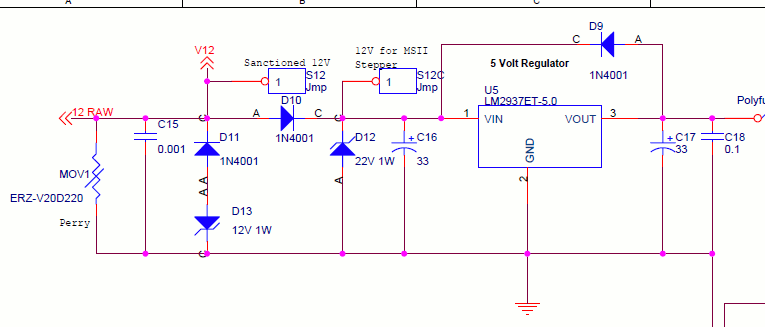C16 exploded, carnage inside
#1
Thread Starter
Senior Member
iTrader: (1)
Joined: Dec 2007
Posts: 695
Total Cats: 354
From: San Jose
Damn it stinks in here!
Just released a ton of smoke from C16. New MS3X build according to Frank's 99-05 instructions, finished it last week, did all the voltage tests on the bench from a stim+dc wall wart, everything was ******* perfect. Finally got around to flashing the firmware, things were going fine, I sit down to let it finish and hear a pop. Run over, pull USB cord, brain isn't working, takes me a few extra seconds to pull the DC power. Smoke stops.
There was lots of crap on the bottom of the MS3 board, but a quick douse with some alcohol and it's all gone, except for some hard baked-on crap around these two through-holes.

I got most of it off after taking this picture, but I wanted to know what the traces look like here for those who haven't fucked their **** up. Under closer inspection than I can photograph, it looks like there's a connection between the two plated holes here. These are the holes between the B and the 1 of "USB 1" and the cpu on the top side.
Seems OK to me?
And here's the C16 carnage, for your enjoyment.

Now, I'd like to think I got the orientation on C16 right because I'm an -----retentive jackass and this is the first time I can remember ever letting smoke out of an electronics project after building everything from silly little Heathkits to small ham radios, but there's a first time for everything, and I'm willing to admit when I'm a dumbass.
But really? I must have screwed with this for 20 minutes on the bench measuring the voltages in step 24 several times, plus setting the trimpots. Why the **** would it blow now? I'm powering the stim from DC power supply from an old crappy wireless router, it says 12V, produced 15V at the stim. Still within the realm of what the MOV should handle, and I was seeing a perfect 12V on the CPU connector during testing... What the ****?
So that's a pisser. Besides C16 and C17 (which got lightly toasted), what do I need to replace? What are the chances the CPU board is OK, given the damage and aborted flash?
Thanks guys
Just released a ton of smoke from C16. New MS3X build according to Frank's 99-05 instructions, finished it last week, did all the voltage tests on the bench from a stim+dc wall wart, everything was ******* perfect. Finally got around to flashing the firmware, things were going fine, I sit down to let it finish and hear a pop. Run over, pull USB cord, brain isn't working, takes me a few extra seconds to pull the DC power. Smoke stops.
There was lots of crap on the bottom of the MS3 board, but a quick douse with some alcohol and it's all gone, except for some hard baked-on crap around these two through-holes.

I got most of it off after taking this picture, but I wanted to know what the traces look like here for those who haven't fucked their **** up. Under closer inspection than I can photograph, it looks like there's a connection between the two plated holes here. These are the holes between the B and the 1 of "USB 1" and the cpu on the top side.
Seems OK to me?
And here's the C16 carnage, for your enjoyment.

Now, I'd like to think I got the orientation on C16 right because I'm an -----retentive jackass and this is the first time I can remember ever letting smoke out of an electronics project after building everything from silly little Heathkits to small ham radios, but there's a first time for everything, and I'm willing to admit when I'm a dumbass.
But really? I must have screwed with this for 20 minutes on the bench measuring the voltages in step 24 several times, plus setting the trimpots. Why the **** would it blow now? I'm powering the stim from DC power supply from an old crappy wireless router, it says 12V, produced 15V at the stim. Still within the realm of what the MOV should handle, and I was seeing a perfect 12V on the CPU connector during testing... What the ****?
So that's a pisser. Besides C16 and C17 (which got lightly toasted), what do I need to replace? What are the chances the CPU board is OK, given the damage and aborted flash?
Thanks guys

#3
I've done worse. Probably just c16 is bad and you should replace c17, this typically happens when you accidentally wire 12v to ground inside the CPU somewhere... but myself and reverant have both had it happen with brand new builds, and once powered up in the car, they pop and we replace and change nothing else and it's fine. IIRC reverant said he uses 36v rated ones, vs the ~18v or something ones that come in the kit.
.id have to go over the ms3 daughterbaord i have sitting here to see if those pins you mention so in fact be touching...that could be the cause.
.id have to go over the ms3 daughterbaord i have sitting here to see if those pins you mention so in fact be touching...that could be the cause.
#5
Thread Starter
Senior Member
iTrader: (1)
Joined: Dec 2007
Posts: 695
Total Cats: 354
From: San Jose
Hope those pins are normal and this is just a really crappy wall-wart.
#8
Am I the only one who opened this thread expecting to see something much more dramatic, related to this:
https://www.miataturbo.net/attachmen...ine=1359122345
https://www.miataturbo.net/attachmen...ine=1359122345
#15
Thread Starter
Senior Member
iTrader: (1)
Joined: Dec 2007
Posts: 695
Total Cats: 354
From: San Jose
BOM spec's 22uF, 25V. Rev (or anyone else) - was your 33uF a typo, or a necessary change in capacitance to go along with the change from 25V->35V?
In other words: do I want a 22uF 35V or 33uF 35V?
Also: I went back in through my build process in my mind and realized I definitely installed these caps correctly.
#16
Joined: Sep 2005
Posts: 33,556
Total Cats: 6,933
From: Chicago. (The less-murder part.)

Judging by their position in the circuit, however, the value of these capacitors is not terribly critical. They're just filtering and stabilizing the linear 5v regulator. In fact, I pulled up the datasheet for the LM2937ET-5.0, and it is extremely vague on the point. The sample schematic shows 0.1 µF for C16 and 10 µF for C17, with a note that, for C17 "The minimum output capacitance required to maintain stability is 10 µF (this value may be increased without limit)."
Long story short: 22 µF vs 33 µF is a toss-up. Rev says he likes 33 µF, and that agrees with the schematic, so go for it. The capacitance selection is relatively independent of the voltage rating.
#19
Input is around 14V, and with various flybacks/spikes, and a capacitor that happens to be a little low on the 25V spec (it happens), you get a blown C16 if you are lucky, and if you are unlucky, it blows, shorts and you instantly fry several 12V traces on the mainboard, rendering it useless.
I've had a 0.6% failure rate on these so far.
I've decided to increase the rating to 35V to prevent it. One blown capacitor every 100 ECUs sold costs me more in damages (a full mainboard and shipping under warranty - not to mention the damage dealt to my reputation) than upgrading the infamous C16 to 35V.
Business as usual.
I've had a 0.6% failure rate on these so far.
I've decided to increase the rating to 35V to prevent it. One blown capacitor every 100 ECUs sold costs me more in damages (a full mainboard and shipping under warranty - not to mention the damage dealt to my reputation) than upgrading the infamous C16 to 35V.
Business as usual.

#20
Thread Starter
Senior Member
iTrader: (1)
Joined: Dec 2007
Posts: 695
Total Cats: 354
From: San Jose
So I finally got to sit down with this today. The vias were in fact bridged and it looked and acted like solder to me. A few minutes with the iron and some wick did the trick. They are no longer connected electronically.
Now waiting on new caps from digikey.
IIRC, the daughter card schematics are not open-source, but does anyone know what those two vias went to?
Now waiting on new caps from digikey.
IIRC, the daughter card schematics are not open-source, but does anyone know what those two vias went to?

















